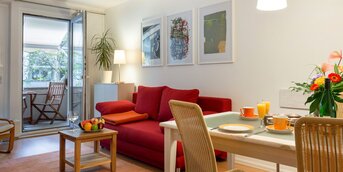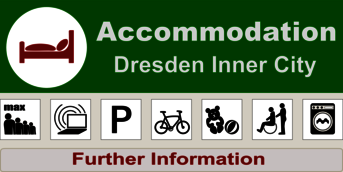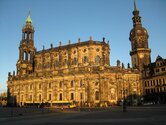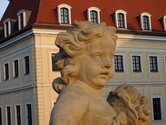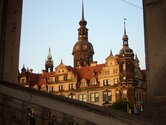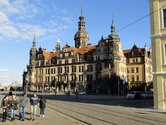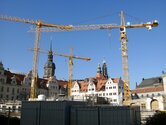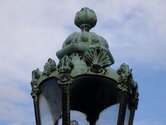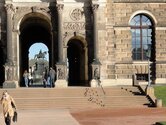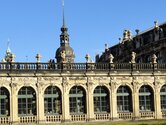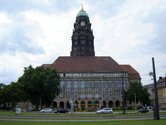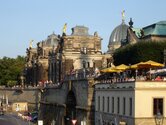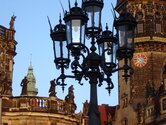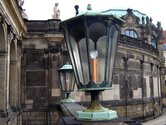The Palace Complex in Dresden
After the bombing of Dresden in February 1945 its inhabitants faced on this very spot a huge heap of rubble with some heavenward ruins. While the art treasures had precautious been taken to different places, the major part of the valuable interior of many halls and state apartments was lost forever. In times of the GDR (German Democratic Republic) attempts to restore the buildings went on very hesitant, and just after 1990 an amazing amount of reconstruction has occurred, to re-arise this unique ensemble of buildings in its old splendour.
Dresden Castle
Dresden Castle is one of the most important examples of Renaissance architecture in Germany. Over more than seven centuries it was the residence of the Electors and Kings of Saxony from the House of Wettin. As the oldest building of Dresden it originates in a mediaeval castle, which was extended in the fifteenth century and became a castle with four wings. In the sixteenth century an extension in the Renaissance style was added and in the nineteenth century again it took its current shape in the neo-Renaissance style. Today you can find several museums in the castle: Green Vault (Grünes Gewölbe), Armoury, Copperplate Engraving Cabinet (Kupferstichkabinett), Coin Cabinet (Münzkabinett), Middle Ages Section of the Sculpture Collection (Skulpturensammlung).
Catholic Hofkirche
As August the Strong (1670 – 1733) had converted to the Catholic religion in order to became King of Poland, it was necessary to establish a sign of religious importance in the since 1539 Protestant Dresden. Thus he ordered the building of the Hofkirche. The church was consecrated in 1751. After nearly 40 years of reconstruction, to remedy the defects of war, today you can experience the church as a brightly decorated jewel of the historical city centre of Dresden.
The Fürstenzug (Procession of the Princes) – the Saxon sovereigns
Since 1876 the Fürstenzug has decorated the outside facade in the Augustusstraße. With its length of 102 metres and a surface of 957 square metres it is the world’s largest porcelain picture. It reveals an original chronicle of the House of Wettin with 35 Saxon margraves, duke, electors and kings, who reigned between 1123 and 1904, and 58 further persons.
Johanneum
This building was originally constructed in 1590 for housing the electoral horses and coaches. In immediate vicinity to the tournament grounds in Stable Courtyard the Electoral Armoury and Harness Chamber was also brought here soon. After the reconstruction after World War II in 1954 the Transport Museum (Verkehrsmuseum Dresden) moved in here.
Taschenberg Palace
August the Strong (1670 – 1733) had the Taschenberg Palace built in 1711 besides the Dresden Castle as the residence for his famous mistress countess Cosel (1680 – 1765). The Palace received its name from the Taschenberg, the hillock on the Elbe bank, on which Dresden Castle was erected then. The bombing in February 1945 left only some fragments of the walls of the Taschenberg Palace. Today the 1995 rebuilt Taschenberg Palace is a five star hotel.
Georgentor Gate
The Georgentor Gate, built in 1535, and the first Renaissance building of Dresden, originally was the town’s fortress’ exit to the river Elbe. Behind the masterly shaped neo-Renaissance facade (developed after the conversion 1889 – 1901) the electoral and royal apartments respectively lie quiet, which will be opened to the public in the near future.
Augustusbruecke bridge
Since 1287 there has been a stone crossing over the river Elbe on this very spot. Today’s Bridge had to be built between 1907 and 1910 because the old construction could not provide enough clearance for shipping traffic. It is made up of a reinforced concrete structure, 355 metres long and 17 metres wide, with a sandstone facing. The form of the piers with their crowning alcoves are based on the preceding baroque building. At the opposit bank of the Elbe, guests can find the Barockviertel District. Here are our offered holiday apartments in Dresden.
An extensive renovation of the Augustusbruecke bridge began in April 2017, which ended after a construction period of almost 5 years (originally only 2 years were planned) by the reopening on January 28, 2022.

